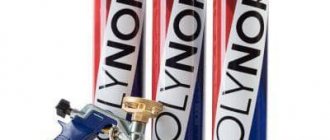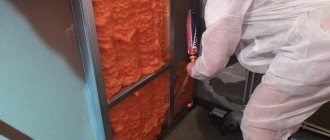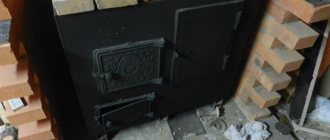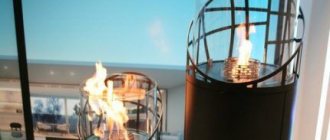Spray polyurethane foam Polynor
Single-component insulation Polinor is an innovation from Kazan. POLYNOR spray insulation is a type of foamed plastic that contains 90% air and 10% solids. This structure gives the material, in addition to thermal insulation qualities, also a large percentage of noise absorption. Unlike foam rubber, it is applied in a continuous layer without a single gap.
Characteristics of Polynor:
- Coating thickness 2.5-6 cm;
- Water absorption 2%;
- Density 18-28 kg/m3;
- Thermal conductivity 0.023-0.025 W/mK
- Service life about 35 years
- Setting speed at 20 °C – 40 minutes, complete drying – 3 days;
- Combustion: self-extinguishing substance.
Checking the screwdriver battery
To determine the actual basic parameters of the battery, a test is carried out.
Battery cells may change their capacity
The screwdriver battery is checked when fully charged. A complete check takes place in several stages.
Verification Tools
The electrical storage can be checked using:
- 15 V DC voltmeter;
- DC ammeter and voltmeter;
- tester;
- multimeter.
The tools you should get are:
- pliers;
- screwdriver;
- with a knife;
- soldering iron
First stage of verification
Readings are taken periodically
So, half an hour after the start of charging, the voltage value will be 13 V. If you measure another half hour, the voltage will be 13.5 V. 2 hours after the start of charging, the voltage will already be about 14 V. This indicates that the maximum has been reached. A fully charged battery has a voltage of 17 V.
You can evaluate the quality of the drive by measuring the current during the charging process. If the battery is in good condition, then it is characterized by a steady increase in current of 1 hour during the charging process. Passing the 1 A current mark indicates normal operation of the drive.
some elements in the battery are not working
Based on the results of the first test, you can get an initial impression of the performance of the battery cells. This will help determine the need to disassemble the battery.
Test under load
To answer the question of how long it will take for the battery to discharge, you should check the drive under load. The load must be selected based on the power of the drive. If it is unknown, then it is assumed that the load power is equal to half the product of the current that is given to the battery during operation and the storage voltage. As a rule, this value is taken to be 35–40 W. Thus, you can use a car headlight (35 W) as a load or use a 12 V spot lamp with the same power.
the battery has a damaged element
Checking the drive's batteries
So, let it turn out that with the help of preliminary checks the presence of faulty elements in the drive was established. Then it is necessary to disassemble the battery and remove the batteries connected in series - “banks”. As mentioned above, the battery consists of 10–12 such cells with a voltage of 1.2 V.
After the inspection, the voltage of each of the “cans” should be measured. The voltage of one cell should not be less than 1.2 V. When carrying out measurements, battery cells should be disconnected from connections with all kinds of sensors. The measuring device is connected to the battery poles. “Banks” with reduced voltage must be replaced. If a simple measurement did not reveal faulty elements, you should measure the “cans” under load.
Checking by resistance value
The ability of each battery to function properly can be checked by comparing the “banks” by internal resistance. The value is determined by dividing the operating parameters voltage by current and subtracting the load resistance.
As a load you should take a resistor with a resistance of 10 ohms
For a better understanding, here are some example calculations. Let’s say that during measurements under load, data was obtained for one “can”: operating voltage - 1.19 V and operating current - 112 mA. Before making the calculation, do not forget to convert the current value from mA to A - 0.112 A. We perform the appropriate actions (1.19 / 0.112) - 10 = 0.63 Ohm. Recall that the subtrahend in our expression is the load resistance of the resistor (10 ohms).
Checking other parameters
Each type of battery has a certain self-discharge value.
So, during a month of storage:
- The nickel-cadmium battery may be discharged by 20%;
- nickel metal hydride - 30%;
- lithium-ion storage – up to 8%.
Checking the power supply elements for the presence of a “memory effect” is carried out by fully charging the battery and completely discharging it. Perform several charge-discharge cycles (3 or 4). The battery can be discharged using a 12 V lamp. During the operation, the residual operating voltage and open circuit voltage are measured. After repeating the cycles many times, the “memory effect” will disappear.
Temperature range Polynor
Users may be interested in the maximum temperature limits that Polynor can withstand. They are different for storage in cylinders, application and direct service of the material at the site of its installation:
- Application from -5°С to +40°С;
- Storage in cylinders down to -50°C, taking into account that such a temperature reduces the yield during subsequent use;
- Operating mode from -60°С to +80°С;
- The maximum possible temperature of use is +121°C. In this case, the service life will be no more than a year.
Calculator for calculating the number of components
When we sprayed polyurethane foam, we developed and used a special calculator to submit a commercial proposal to the Customer and to calculate the required amount of raw materials. This is a table in MS Ecxel in which we divided the object into areas that differ from each other by area, and also introduced correction factors for each area. As a basic reference, we took the consumption of raw materials for spraying 1 square meter of 1 cm thick polyurethane foam of a certain density under ideal conditions. When calculating, the area of the site was multiplied by the base flow rate, then by the layer thickness, and then by the necessary correction factors that took into account the above factors. Ultimately, the consumption at each site was summed up, and we received the consumption of components at the site. Periodically, we made changes to this calculator, and somewhere in the second year it began to produce results with sufficient accuracy.
For more information on this topic, see:
Polinor, which has become a new product on the market of thermal insulation materials, is a modern version of foam rubber produced by Kazan. The excellent heat-saving qualities of this material have been known for a long time. Foam rubber was used to insulate partitions and entrance doors, fill mattresses, etc.
Difference from polyurethane foam
Both polyurethane foam and Polinor are essentially polyurethane foam, but they have different qualities:
- A) Thermal insulation: polyurethane foam has open cells, in Polinor 70% of the cells are closed;
- B) Moisture absorption: polyurethane foam absorbs and then releases water, Polinor does not absorb it;
- C) Polinor is a self-extinguishing product in relation to combustion, i.e. does not support combustion;
- D) The main distinguishing feature of Polynor sprayed polyurethane foam is the “torch” for high-quality spraying.
Application area
Sprayed polyurethane foam has found its place in almost every area:
- large-scale and individual construction - creation of a heat-insulating and waterproof layer (roofing work, blocking the access of cold air through walls, windows, doors, balconies, basements, bathhouses, foundation);
- prefabricated structures - creation of sandwich panels;
- furniture production - the use of an elastic urethane foam layer (foam rubber) in the creation of mattresses, upholstery, seats;
- freezing units – protection against cold leakage for household and industrial appliances;
- pipeline transport – insulation of pipes for various purposes (petroleum products);
- heating networks – preventing hot water supply from cooling down;
- automotive industry - application in the arrangement of car interiors, creation of bumpers;
- equipment – vibration protection of electrical devices, waterproofing of contact connections;
- aircraft construction – protection against heat loss, noise insulation;
- carriage building – fire-resistant materials, noise reduction, thermal insulation properties;
- transport refrigeration equipment – microclimate support;
- design – creation of decorative products, jewelry, stucco moldings.
This material has conquered the whole world. Its ability to stick to almost any surface, even pipes, has come in handy for many. People sleep on it, sit on it, without knowing it.
How to use Polinor insulation
This insulating material is produced in the form of an aerosol in cylinders with a volume of 1 liter. The contents of the cylinder are a pink polymer substance. When sprayed with a special gun, polyurethane foam forms a dense foam , filling the space without a single gap. The liquid form helps the substance penetrate into cracks and cracks, as well as any hard-to-reach places. In addition, it is able to reliably adhere to any surface: metal, brick, wood (including plywood and chipboard), paint, concrete, etc.
Precautionary measures
Despite the safety of the Polinor composition, it is recommended to observe the following precautions when performing insulation measures.
• When the composition is released from the cylinder, an increased concentration of the chemical components of the insulator is observed, which can cause irritation of the mucous membranes of the eyes, respiratory organs, and skin. Therefore, work should be carried out in special clothing, safety glasses, a mask or a respirator
• When the composition is released from the cylinder, there is an increased concentration of the chemical components of the insulator, which can cause irritation of the mucous membranes of the eyes, respiratory organs, and skin. Therefore, work should be carried out in special clothing, safety glasses, a mask or a respirator.
• Do not spray the contents of the cylinder near an open flame. The presence of gas may cause a fire. It is also prohibited to combine installation with smoking cigarettes.
• In the room where thermal protection is installed, you need to open windows and doors to organize good air ventilation.
In general, working with polyurethane foam insulator Polinor, produced in cylinders, is characterized by simplicity and uncomplicated application techniques, which is confirmed by user reviews.
Reviews about Polynor on forums
How to find out about the quality of a product? From advertising? Of course not, based on reviews from real users. We invite you to find out people's opinions about the popular insulation called Polinor.
Many users have done an excellent job insulating a large area:
I live on the first floor of a panel high-rise building; I had to insulate the floor on the basement side. I will say that Polinor has excellent adhesion to concrete, it sprays very well and it took 36 m2 to foam in just 2 hours. However, the smell of this penalty is unpleasant, it was heavily inhaled, but there are no windows in the basement. I believe that you can only work with such substances in a well-ventilated area.
Conclusion: a cool thing , but very toxic.
Andrey, reviews about Polinor
With the arrival of cold weather, it turned out that our floor simply did not have thermal insulation - I refer to the uncleanliness of the builders. There was such a pull from the floor that my legs were freezing, so it was decided to insulate them. Builders in the advertisements asked for up to a thousand rubles per m2 , so for 44 m2 it turns out to be a lot... After studying the topic a little, I realized that I didn’t particularly need a PPU installation. My choice fell on Polynor. Calculation: 1 can per 1 m2, so for my area I got 4 packages for 16 thousand rubles. It would be possible to use cheaper slabs made of expanded polystyrene, but then the formation of cracks is inevitable, and in my case this is exactly what should not happen, because it blows furiously.
I worked on damp earth, which, of course, was cold, damp and cramped, but there were no problems with spraying. In 3.5 hours I inflated from 3 to 5 cm of a continuous layer of 47 balloons.
As a result, my house does not have time to cool down completely over the weekend with the heating turned off.
Andrey S., construction forum
I decided to insulate my house from timber, despite the rather expensive cost. By the way, if you buy in bulk, you can hope for a discount.
Personally, I liked Polinor because you don’t need any special skills or equipment to work with it. There is no need to prepare it, for example, mix or heat anything. This means that you can do without inviting specialists, and this is already a tangible financial saving.
Mikhail, product reviews
There are opinions that the advertising of this insulation is exaggerated:
My opinion is that one-component polyurethane foam is much inferior to two-component foam . Thus, when foaming a one-component composition, the cells contain air, and a two-component composition contains freon, which is even less thermally conductive. In addition, narrow, deep places cannot be filled with cylinder pressure.
Alexander, construction forum
I don’t believe that this polyurethane foam does not burn, besides, such indicators as 70% of closed cells were taken from the ceiling, so to speak, for the sake of beautiful numbers. The price is prohibitively high.
Victor, online form
Application technology
The most common method of polyurethane foam insulation is spraying onto the structural elements of the building.
PPU is sprayed onto the walls.
But there is another way - pouring, which requires a space closed on all sides. It is mainly used in factories producing sandwich panels.
Filling with polyurethane foam.
On the floor
Before spraying insulation on the base of the floor, preparatory work is carried out, including: removing the old screed, repairing the concrete base (in a wooden house the subfloor is being restored), waterproofing the ceiling or subfloor. The preparatory process is described in more detail in the material “Preparing the floor for pouring screed.”
A lathing for laminate, parquet, linoleum or joists for floorboards is mounted on the prepared surface. At the same time, both the sheathing slats and the joists should be 20-30 mm higher than the insulation. The gap is necessary to ensure ventilation.
On the walls
The technology for insulating the facade and walls from inside the room is the same. Consists of sequential operations:
the old finish is removed from the surface of the walls (you can see how to quickly remove it in the work “Aligning walls for painting”); the sheathing is installed; polyurethane foam is sprayed
In this case, special attention must be paid to corners, crevices and voids; areas with protruding insulation are trimmed with a knife (easy to detect as a rule); Drywall is attached to the sheathing for finishing with wallpaper, painting or decorative plaster.
To the ceiling
Insulation of the PPU ceiling is carried out under a suspended or suspended ceiling. In this case, the old finish is removed from the surface of the floor slab, after which foam is applied in a thin layer (lathing is not required).
On the roof
The roof is one of the few places in the house where you can do polyurethane foam insulation work yourself. To do this, you need to buy special kits with 2 small cylinders and a sprayer. The containers contain the starting reagents, and a sprayer is needed to mix the components. But before starting work, you need to calculate the financial costs so that the roof does not literally turn out to be golden.
Semi-professional kit for PPU insulation.
Preparing the roof for insulation is simple: the surface is dust-free and dried. PPU is applied from the inside between the rafters. After the foam has hardened, the thermal insulation layer is covered with sheets of plywood or OSB.
PPU roof insulation scheme.
The editors of the portal StroyGuru.Com tried to objectively talk about such a controversial insulation material as polyurethane foam. Having complete information about the material, you can make an informed choice and avoid mistakes.
Most popular brands
The construction market is filled with foam insulation materials of domestic and foreign production. The following brands received the greatest number of positive reviews:
- Ecotermix;
- Titanium;
- TechnoNIKOL;
- Technology;
- Teplis;
- Polinor;
- Phorum;
- Penosil;
- Penoplex Fastfix;
- Home master;
- Sipur;
- Tri color.
When choosing a material, you need to carefully study the instructions for use, last of all, focusing on the price of the product.
Installation
When using Polinor there is no need to purchase expensive spray equipment. To get started, just put a specialized gun on the cylinder and press the trigger. The mixture has a high spray speed, it can be easily applied to flat surfaces such as walls and floors, and also squeezed onto the ceiling without fear of leakage or falling off.
It is important to note that after the first pull on the trigger, strong pressure is created, as a result of which too much of the spray mixture may come out. To avoid this, it is recommended to make the first descent within an interval of no longer than 1-2 seconds. https://www.youtube.com/embed/rrTgODEWHaI
A good performance quality of Polinor is that the user has the ability to independently regulate the thickness of the applied mixture. With uniform spraying, you can achieve a layer of any size without seams.
There is no need for special surface treatment before applying polyurethane spray; it is enough to simply clean it of visible large contaminants.
Nuances
It is important to apply the mixture after shaking the container. Moreover, it must be at room temperature! It is best to spray the insulator onto a damp surface, which guarantees excellent adhesion. Applying 1 layer is usually not enough, so after it dries, you should spray a second one so that the total thickness is around 40-50 mm
During operation, the cylinder should be shaken regularly, and at the end of the action, remove the gun and wash it, which makes it possible to use it on new containers with a heat insulator
Applying 1 layer is usually not enough, so after it has dried, you should spray a second one so that the total thickness is around 40-50 mm. During operation, the cylinder should be shaken regularly, and at the end of the action, remove the gun and wash it, which makes it possible to use it on new containers with a heat insulator.
If, after the protective layer has dried, any damage or chips are found, they can be easily eliminated by applying a new layer of polyurethane insulator on top of the defective area. To increase fire-fighting properties, the material is treated with a special composition that will provide the surface with flammability class G1.
After applying the material and completely drying, it can be painted or plastered, as well as covered with plasterboard.
POLYNOR is an excellent innovative high-quality material, through the use of which it is possible to achieve effective insulation of structures and reduce heating costs.
The most popular brands of industrial heat insulation
Ecotermix. It is made on the basis of vegetable oils, and foaming occurs due to a substance that contains water. The product has a low content of components that negatively affect human health. There are 2 grades: 300 and 600. The first is intended for application to external surfaces, and the second to internal walls. This is due to the fact that brand 300 has a closed structure, and 600 has an open structure.
Sealection 500. The material is manufactured by the American company Demilec, has an open structure and a G2 fire safety class.
Healtok Soy 200. This raw material has a closed structure. Produced from soybean oil and polymer residues. After spraying, the dimensions increase 50 times, securely fixing to surfaces of any materials, filling all existing cracks and voids.
Uniqueness of the material
- This is a one-component polyurethane foam insulation, unlike other sprayed polymer compounds. There are no analogues on the domestic market.
- Extreme ease of use - anyone can apply the composition; no special equipment is required.
- No electrical connection is required as no electric sprayers are used.
- Transporting and storing Polynor is extremely easy, because... it is packaged in small containers. This is much more convenient than transporting mineral wool or polystyrene boards.
- Packing small volumes allows you to do without leftover material. Exactly as much as required is used.
- During the foaming process, carbon dioxide is formed in the bubbles of the material. It has low thermal conductivity, which increases the thermal insulation characteristics of the insulation layer.
polynor.ru
Instead of an epilogue
An analysis of the domestic market for modern sprayed insulation materials has revealed that it is largely represented by Russian manufacturers. The reason for this situation is the simple production technology of such substances, as well as the economic inexpediency of importing foreign analogues. Practice shows that Russian samples are in no way inferior to Western and Asian ones, and in most cases they are simply superior to them. Moreover, they are equally suitable for small household and large-scale industrial work. The diversity of this market is also not subject to criticism - there are a great many models and choosing an option for a specific task and at an adequate price is not difficult. However, it is worth mentioning that retail is far from being saturated with industrial-grade compounds that are useful during construction work. In most cases, such compositions are mixed by professionals themselves in order to maintain the required proportions for the final layer.
Features for comparison
Everything is learned by comparison, right? Therefore, in addition to Polinor, its potential rivals for our wallets are indicated. We look at the table and compare.
I don’t know about others, but insulation with Polinor will cost approximately 400 -450 rubles per square meter. Of course, there are not a few more indicators here
However, I decided not to bother your attention. I think this is enough
But... there remains one more important point - the price. It would be correct to name the price for a “rough” thermal insulation coating with an area of 1 sq. m.
I hope the information presented looks objective and will be useful to someone.
Insulation of walls from the inside
A parable about insulating a roof with your own hands: Once upon a time there lived a pitched roof and one day she decided to insulate herself with her own hands. But back and forth, my hands don’t get there all the time. Then the roof decided to become flat. And so she did. And soon winter came, snow fell, then more, more and more... As a result, the insulation of the flat roof happened without the help of hands.
That's all for now. Read and subscribe to the blog, recommend to friends.
Good luck and light spraying! See you in the next articles...
Quote of wisdom: Women without male company fade, and men without female company become stupid.
https://youtube.com/watch?v=kU5FQ8WIr7U
Why is it profitable to buy polyurethane foam in cylinders?
To be fair, we note that in addition to mini PU foam in 1000 ml containers, in Russia there are also disposable [rechargeable in the USA] PU foam kits in steel Foam Kit cylinders.
If you are trying to understand how good Polinor or Sipur are as PPU polyurethane foam, then you should compare it with the Foam Kit. It is incorrect to compare polyurethane foam from a cylinder with the foam obtained during application by the installation. Application areas differ.
Let's be honest: if the object is large enough, there are electrical connection points of sufficient power for equipment and a compressor, and it is possible to bring and unload barrels of material, then you should hire professionals with special equipment and entrust them with spraying polyurethane foam for insulation.
The Foam Kit consists of 2 pressurized metal cans with components. A nozzle-gun is connected to the cylinders through flexible tubes. If you open the taps, liquid R-component and ISO under pressure enter the nozzle and spray onto the surface.
The difference from Polinor and SiPur is that there are 2 large steel cylinders, and not 1 small and light cylinder. But, of course, weight and dimensions are not the main thing here. The main thing is money. Better is the polyurethane foam that is cheaper, because... The performance characteristics of both products are the same.
Cost of insulation per 1m2 of polyurethane foam from a cylinder
From an economic point of view, domestic mini PPU are more profitable. The fact is that FoamKit is produced and imported from the USA, i.e. purchased for foreign currency. At the current ruble to dollar exchange rate (today, for example, 60 rubles per 1 USD), a domestic product is cheaper than an imported analogue.
The benefits of purchasing liquid polyurethane foam in cylinders will be obvious if you compare the cost of 1 m2 of insulation, 10 mm thick, obtained from a SiPur polyurethane foam cylinder with the price of the same square meter from FoamKit 200.
The subscripts 200, 300, 600 and 1000 indicate how many square feet of surface area can be insulated with 1-inch thick polyurethane foam produced from such a cylinder.
Those. FoamKit 200 is rated to insulate 200 square feet at 1 inch thickness. For a better understanding, let's convert to the metric measurement system. 1 foot is equal to 0.3 m. 1 inch is 2.5 cm. Thus, a disposable FoamKit 200 kit under normal conditions will allow you to insulate 18 m2 with a thickness of 2.5 cm or obtain 0.45 m3 of lightweight polyurethane foam, i.e. 45m2 with a thickness of 1cm.











